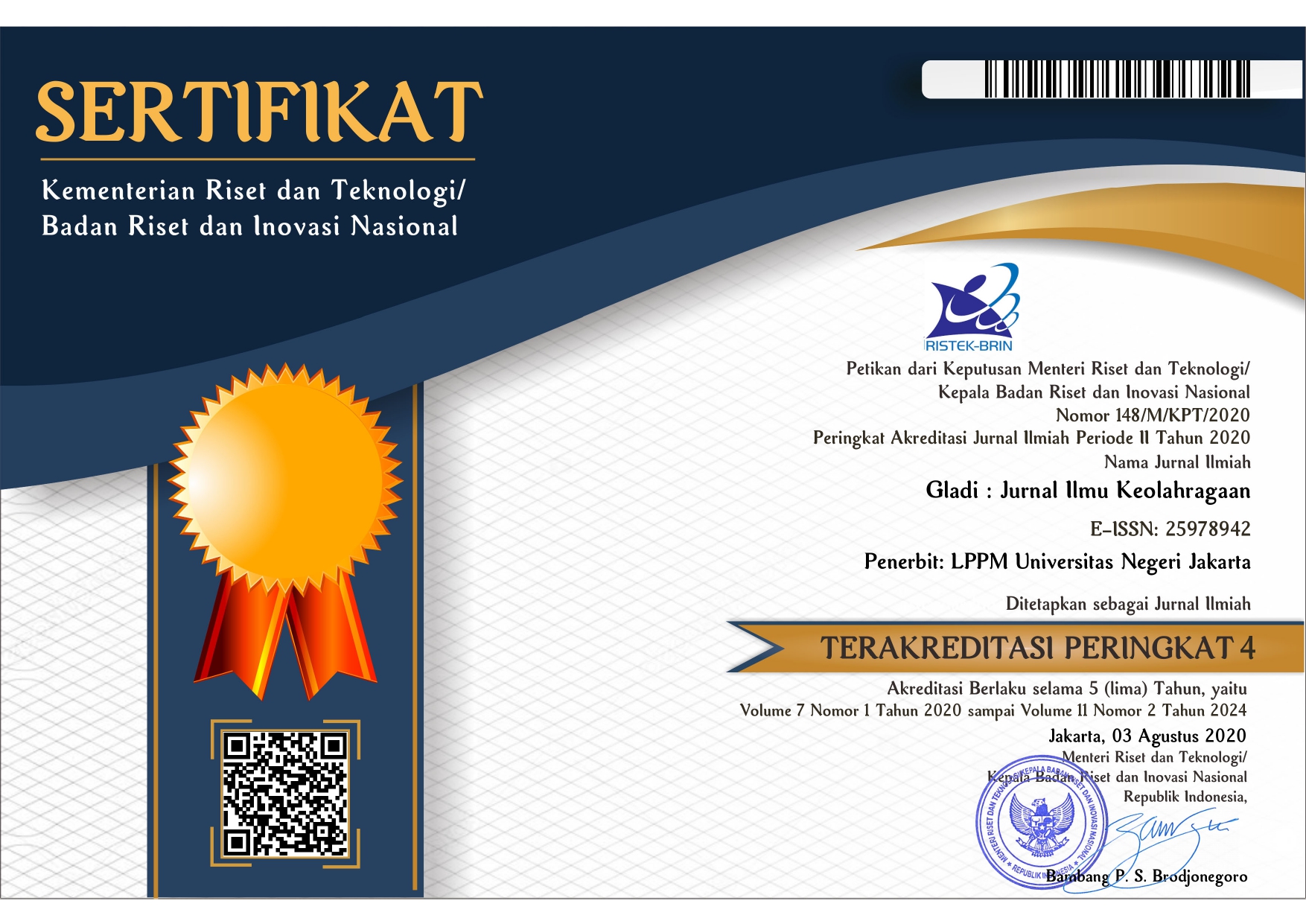The Effect Of Hand-Eye Coordination And Confidence On Badminton Smash Shot
Keywords:
hand-eye coordination, confidence, badminton smash shotAbstract
This study aims to determine the relationship between hand-eye coordination and confidence in badminton smash shots. The research methods used are an associative quantitative approach, a survey method with test and measurement techniques while the data analysis technique uses a path analysis approach. The study population is beginner athletes at the Gold Badminton Club and Sarwendah Badminton Club. The sampling technique used with total sampling is that the entire population is used as a sample. Based on the results of the data calculation, the value of Fcal = 4.612 was obtained and it was known that the significance value (Sig.) in the F test was 0.041. Because Sig. 0.041 < 0.05, it can be concluded that hand-eye coordination significantly affects the skill of the badminton game. For the calculation of confidence, the value of Fcal = 8.587 was obtained and it was known that the significance value (Sig.) in the F test was 0.007. Because Sig. 0.007 < 0.05, it can be concluded that Confidence (X2) has an effect on the Badminton Game smash hitting skill (Y) or means significant. So it can be concluded that based on the output table, the value of the coefficient or R square is 0.141. This value means that the influence of hand-eye coordination (X1) on the smash stroke skill of the badminton game (Y) is 14.1%, while the rest is influenced by other factors. Meanwhile, based on the output table, the value of the coefficient or R square is 0.235. This value means that the influence of Confidence (X2) on the smash hitting skill of the badminton game (Y) is 23.5% while the rest is influenced by other factors.
Downloads
References
Apriansyah, B., Sulaiman, & Mukarromah, S. B. (2017). Contribution of Motivation, Cooperation, Confidence to the Athlete Achievement of the Pati Training Center Football School in Pati Regency. Journal of Physical Education and Sports, 6(2), 101–107.
Aristiani, R. (2016). Increasing student confidence through audiovisual assisted information services. Journal of Gusjigang Counseling, 2(2), 182–189. https://doi.org/10.24176/jkg.v2i2.717
Brewer, B. W. (2009). Injury prevention and rehabilitation. Wiley-Blackwell.
Dupri. (2016). The Relationship between Explosive Power of Arm Muscles and Eye-Hand Coordination on the Service Ability of Kuansing Volleyball Athletes, Kuantan Singingi Regency. Journal Sport Area, 1(2), 23–30. https://doi.org/10.25299/sportarea.2016.vol1(2).385
Fransisca, R., Wulan, S., & Supena, A. (2020). Increase Children's Confidence with Educational Snake and Ladder Games. Journal of Obsession: Journal of Early Childhood Education, 4(2), 630. https://doi.org/10.31004/obsesi.v4i2.405
Gunawan, R., Subarjah, H., & Sudirjo, E. (2017). Comparison between shadow training methods and color touch games on badminton footwork skills. UPI Journal, 1–10.
Hays, K., Thomas, O., Maynard, I., & Bawden, M. (2009). The role of confidence in world-class sport performance. Journal of Sports Sciences, 27(11), 1185–1199. https://doi.org/10.1080/02640410903089798
Jarvis, M. (2005). Sport psychology: Routledge Modular Psychology.
Kurniawan, F., Santoso, D. A., & Setiawan, W. (2020). Psychological Analysis of Football Athletes' Confidence. Journal of Physical Education, 1(2), 47–58.
Mauludy, N. G., & Sartono, H. (2017a). The relationship between eye and hand coordination with the results of drive strokes in badminton. Journal of Sports Coaching, 9(1), 64–71.
Mauludy, Nuansa. G., & Sartono, H. (2017b). The relationship between eye and hand coordination with the results of drive strokes in badminton. Journal of Sports Coaching, 9(1), 64–71.
Mirhan, M., & Jusuf, J. B. K. (2016). The Relationship between Confidence and Hard Work in Sports and Life Skills. Journal of Achievement Sports, 12(1), 86–96.
Muliana, A., Bismar, A. R., & Suwardi, S. (2019). THE EFFECT OF EYE-HAND COORDINATION, ARM MUSCLE STRENGTH AND WRIST FLEXIBILITY ON THE ABILITY OF LONG SERVE STROKES IN BADMINTON AT CLUB PB. MATRIX MAKASSAR. Journal of UNM, 8(5), 55.
Ngenget, I., Makadada, A., & Lasut, J. (2014). The Effect of Arm Muscle Strength Training on the Accuracy of Drive Strokes in Badminton Games in Putera Pb Athlete Mahawu Tomohon. Journal of Vini Vidi Vici, 2(1).
Oki Candra, Asmawi, Moch., & Tangkudung, J. (2017). The Effect Leg Muscle Explosive Power, Flexibility, Hand Eye Coordination And Confidence Of Skill Lay Up Shoot Basketball. Journal of Chemical Information and Modeling, 3(2), 162.
Poole, J. (2009). Learn Badminton. Pioneer Jaya.
Prawiratama, M. R., & Aulia, P. (2020). The Effect of Mental Training on the Confidence of Football Athletes of the Persegat Padang Pariaman Academy. Tambusai Education Journal, 4(3), 3395–3402.
Setiawan, A., Effendi, F., & Toha, M. (2020). Badminton Forehand Smash Accuracy is Associated with Arm Muscle Strength and Eye-Hand Coordination. MAENPO Journal: Journal of Physical Education Health and Recreation, 10(1), 50. https://doi.org/10.35194/jm.v10i1.949
Setyobroto, S. (2001). Mental Training. Printing "Solo."
Sin, T. H. (2017). The Confidence Level of Football Athletes in Facing the Match. Journal of Counseling Focus, 3(2), 163. https://doi.org/10.26638/jfk.414.2099
Subarkah, A., & Marani, I. N. (2020). Analysis of the basic technique of stroke in the game of badminton. Menssana Journal, 5 No.2, 146–156.
Sukadiyanto. (2011). Introduction to Physical Training Theory and Methodology. PKO FIK UNY.
Tangkudung, J. (2012). Sports Coaching. Cerdas Jaya.
Tangkudung, J. (2016). Various research methodologies, descriptions, and examples. Lensa Media Pustaka Indonesia.
Yulianto, F., & Nashori, H. F. (2006). Confidence and Achievements of DIY Taekwondo Athletes. Journal of Psychology, Diponegoro University, 3(1), 55–62.
Zulbahri, & Melinda, C. (2019). Practice Style and Guided Discovery Style Methods as well as Basic Technical Skills of Badminton Athletes. Proceedings of SENFIKS (National Seminar of the Faculty of Health Sciences and Sciences), 1(1), 28–37.







